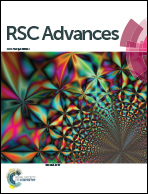The influence of phosphine ligand substituted [2Fe2S] model complexes as electro-catalyst on proton reduction†
Abstract
To probe the influence of phosphine ligand substitution on the well-known [2Fe2S] model, two new [FeFe]-hydrogenase model complexes with the phosphine ligands, PMe3 or P(CH3O)3, were synthesized, such as μ-(SCH(CH2CH3)CH2S)–Fe2(CO)5PMe3 1, and μ-(SCH(CH2CH3)CH2S)–Fe2(CO)5P(CH3O)3 2 Confirmation of structures was provided by FTIR, 1H NMR, 13C NMR, 31P NMR, elemental analyses and single-crystal X-ray analysis. The crystal structure of complex 2 shows that the P(CH3O)3 ligand has less steric effect on the coordination geometry of the Fe atom than the PMe3 ligand. In the presence of HOAc in CH3CN solution, the hydrogen evolution overpotentials of complexes 1 and 2 were 0.91 V and 0.81 V, respectively. Comparatively, complex 2 produces hydrogen at an overpotential of 0.1 V, lower than that for complex 1. A further electrocatalytic study showed the maximum charges for 1 and 2 were 31.3 mC and 56.3 mC at −2.30 V for 10 min, respectively. These studies showed that the complexes 1 and 2 have the ability, as novel electrocatalysts, for catalysis of hydrogen production, and complex 2 has better electrocatalytic ability than complex 1.
![Graphical abstract: The influence of phosphine ligand substituted [2Fe2S] model complexes as electro-catalyst on proton reduction](/en/Image/Get?imageInfo.ImageType=GA&imageInfo.ImageIdentifier.ManuscriptID=C8RA08016J&imageInfo.ImageIdentifier.Year=2018)


 Please wait while we load your content...
Please wait while we load your content...